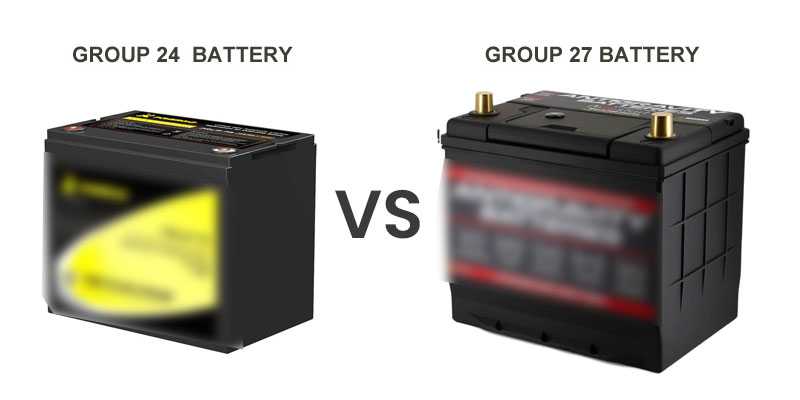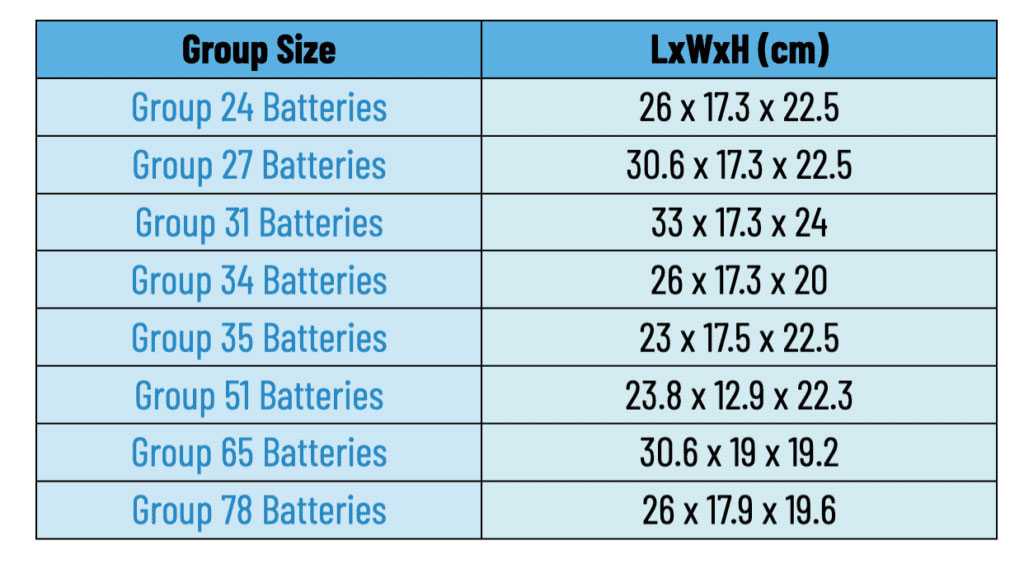Welcome to the world of marine batteries! Before you embark on your sea adventure, a reliable marine battery is essential for powering your boat’s electrical systems. Whether it’s lights, navigation gear, or a trolling motor, the right marine battery ensures a smooth boating experience. In this article, we’ll explore the differences between Group 24 and Group 27 marine batteries, helping you choose the one that suits your needs. (Read: BCI Battery Group Size Chart Guide and BCI Group Battery Factory Wholesale)

Understanding battery group sizes
Understanding marine battery group sizes is crucial for choosing the right one for your boat. Here’s a simplified guide focusing on Group 24 and Group 27:
- Group Sizes Basics:
- Group sizes determine the physical dimensions and terminal placement of marine batteries.
- These standardized sizes ensure proper fit in different boats.
- Difference Between Group 24 and Group 27:
- Group 24 has a smaller amp-hour rating compared to Group 27, meaning less energy storage and potentially shorter runtime.
- Group 27 offers more amp-hours, providing greater capacity and potential for longer usage.
- Choosing the Right Size:
- Consider your boat’s power requirements when choosing between Group 24 and Group 27.
- Group 24 suits minimal needs or limited space, while Group 27 is ideal for more power-demanding setups with ample space.
- Balancing Energy, Space, and Budget:
- Your choice depends on balancing energy needs with available space and budget considerations.
- Consult with experts for guidance based on your specific boating setup.
Understanding these differences helps you make an informed decision based on your boat’s unique requirements. Stay tuned for the next section discussing the pros and cons of each marine battery type!
The difference between Group 24 and Group 27 batteries
Choosing between Group 24 and Group 27 marine batteries requires understanding their differences. Here’s a concise breakdown:
- Group 24 Characteristics:
- Compact size and versatile, ideal for smaller boats or tight spaces.
- Capacity ranges from 75-85 ampere-hours (Ah), suitable for moderate power needs.
- Group 27 Features:
- Slightly larger with a capacity of 90-105 Ah, providing more power over an extended period.
- Measures around 13 inches long, offering increased size compared to Group 24.
- Key Distinctions:
- Both use lead-acid technology known for durability.
- Group 27 batteries are generally heavier than Group 24 counterparts.
- Consideration Factors:
- Choose based on your boat’s specific needs, available space, and power requirements.
- Group 24 is sufficient for limited space and lower power needs, while Group 27 offers more capacity.
- Final Decision Factors:
- Evaluate factors like available space, power requirements, and personal preference for an effective marine battery choice.
By carefully considering these aspects, you can confidently choose the marine battery that best suits your boat’s needs.

Pros and cons of each type of battery
Choosing between Group 24 and Group 27 marine batteries involves considering their pros and cons. Here’s a concise breakdown:
- Pros of Group 24:
- Generally more affordable, making them a budget-friendly choice.
- Smaller and lighter, suitable for boats with limited space.
- Pros of Group 27:
- Higher capacity and longer runtime, ideal for extended usage on the water.
- Suitable for boaters with significant electrical needs or long days on the water.
- Cons to Consider:
- Group 24 may have a lower capacity and shorter runtime due to its smaller size.
- Group 27 tends to be more expensive and heavier.
- Decision Factors:
- Consider your boat’s electrical demands, available space, and budget constraints.
- Evaluate how often you use your boat to determine the most suitable battery type.
- Maintenance Tips:
- Regardless of the type, proper maintenance is crucial for battery lifespan.
- Regularly check the charge level, clean terminals, and follow recommended care practices.
In conclusion, weigh the pros and cons based on your priorities, whether it’s cost, capacity, or space constraints, to make an informed decision on your marine battery choice.
Factors to consider when choosing a marine battery
Selecting the ideal marine battery involves evaluating key factors tailored to your boat’s requirements. Here’s a simplified breakdown:
- Size Consideration:
- Group 24 and Group 27 batteries differ in dimensions.
- Ensure the chosen battery fits snugly into your boat’s designated compartment.
- Capacity and Amp-Hours (Ah):
- Higher Ah rating indicates longer power supply before recharging.
- Consider your electrical needs; more devices or longer usage may require a higher Ah rating.
- Battery Type:
- Three main types: starting, deep cycle, and dual-purpose batteries.
- Select based on your usage—starting for quick bursts, deep cycle for sustained energy, or dual-purpose for a balance.
- Maintenance and Durability:
- Evaluate maintenance requirements; some batteries need regular checks or topping up.
- Assess durability features to ensure the battery withstands marine conditions.
- Price vs. Quality:
- While initial cost matters, investing in a higher-quality battery offers better long-term performance.
- Consider the balance between upfront pricing and long-term value.
In conclusion, tailor your marine battery choice to your specific boating needs, considering size, capacity, type, maintenance, durability, and budget considerations.
Tips for maintaining and prolonging the lifespan of your marine battery
Maintaining and Prolonging the Lifespan of Your Marine Battery:
- Inspect and Clean Regularly:
- Check for dirt and corrosion on your marine battery.
- Clean terminals with a baking soda and water mixture, ensuring thorough drying before reconnecting.
- Proper Storage:
- Store your marine battery in a cool, dry place away from direct sunlight.
- Extreme temperatures can shorten its lifespan.
- Correct Charging Practices:
- Follow manufacturer‘s charging instructions precisely.
- Avoid overcharging or undercharging to prevent damage.
- Smart Charger Usage:
- Invest in a smart charger to adjust the charge rate automatically, preventing overcharging.
- Avoid Deep Discharges:
- Minimize completely draining your marine battery to preserve overall capacity and lifespan.
- Disconnect During Storage:
- When storing your boat for an extended period, disconnect the negative terminal to prevent parasitic drain.
- Handle with Care During Transportation:
- Securely fasten your marine battery during transportation to prevent damage from vibrations or impacts.
Remember, proper maintenance is the key to ensuring your marine battery lasts longer and performs optimally!




























